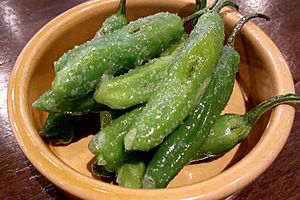Padrón peppers facts for kids
Quick facts for kids Padrón |
|
|---|---|

Raw Padrón peppers
|
|
| Species | Capsicum annuum |
| Origin | Galicia, Spain |
| Scoville scale | 500 to 2,500 SHU |
Padrón peppers, also known as Herbón peppers, are a special type of pepper. They come from a town called Padrón in northwestern Spain. These peppers are a kind of Capsicum annuum, which is the plant family that most common peppers belong to.
Contents
What Are Padrón Peppers Like?
Padrón peppers are small, usually about 2 inches (5 cm) long. They have a long, skinny shape. Most of the time, these peppers are picked and eaten when they are still green. This means they are not fully ripe yet.
Most Padrón peppers have a mild taste. But here's a fun fact: some of them can be quite spicy! This is why people in Galicia, where the peppers come from, have a saying: "Os pementos de Padrón, uns pican e outros non". This means "Padrón peppers, some are hot, some are not."
If the pepper plants do not get enough water, they tend to grow hotter peppers. Also, Padrón peppers get spicier as they get older. When they are fully ripe, their color changes to red.
Where Do Padrón Peppers Grow?
Padrón peppers first came from the town of Padrón. This town is in the A Coruña province of Galicia, in northwestern Spain.
Since 2010, a special European Union law has protected the name "pemento de Herbón". This means only peppers grown in certain areas can use this name. This is called a protected designation of origin.
Today, Padrón peppers are also grown in other places. You can find them growing in parts of the Mediterranean region and in the United States. They are always picked when they are young and green.
How to Cook Padrón Peppers
Padrón peppers are usually cooked by frying them in olive oil. They are fried until their skin starts to bubble up and the pepper gets soft.
In the area around Padrón, people usually remove the stems before frying. Many pepper growers and tourism experts in Galicia suggest taking the stems off. They say the stems can make the fried peppers taste a bit bitter.
However, in other places, people often leave the stems on. The stems can be used as a handle to hold the peppers while you eat them.
Fried Padrón peppers are typically served hot. They are often sprinkled with coarse salt. Sometimes, they come with pieces of bread. They are a popular type of tapas, which are small Spanish snacks.
See also
 In Spanish: Pimiento de Padrón para niños
In Spanish: Pimiento de Padrón para niños


